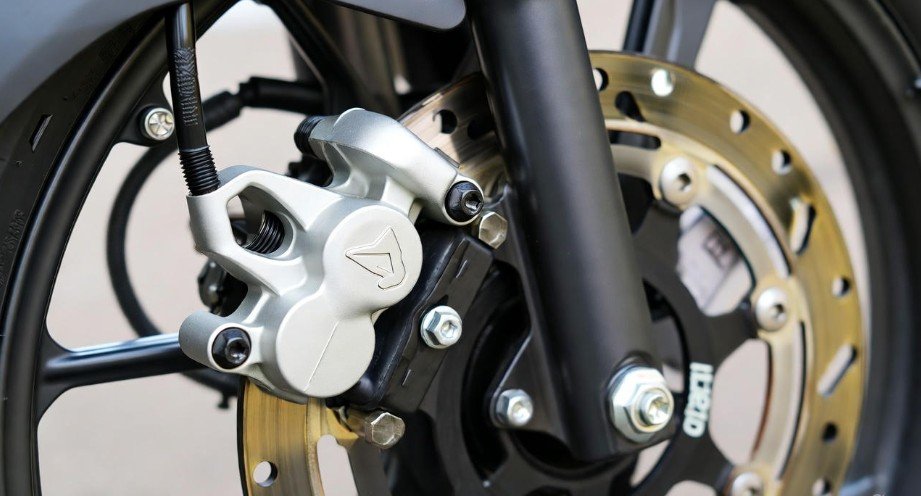Pulsar 220 Front Disc Brake Kit Price

The Pulsar 220 front disc brake kit price can range from $50 to $250, depending on the brand, quality, and whether it’s an OE replacement or an aftermarket upgrade. Understanding these factors helps you find the best value for enhanced braking performance.
In This Article
- 1 Key Takeaways
- 2 Understanding Your Pulsar 220’s Front Disc Brake System
- 3 Factors Influencing Pulsar 220 Front Disc Brake Kit Price
- 4 Average Pulsar 220 Front Disc Brake Kit Price Ranges
- 5 Where to Buy Your Pulsar 220 Front Disc Brake Kit
- 6 DIY Installation vs. Professional Installation
- 7 Steps to Replacing Your Pulsar 220 Front Disc Brake Kit
- 8 Maintenance for Longevity and Performance
- 9 Frequently Asked Questions (FAQs)
- 9.1 Q1: What is the typical lifespan of a Pulsar 220 front disc brake pad?
- 9.2 Q2: Can I use a brake disc from a different motorcycle model on my Pulsar 220?
- 9.3 Q3: How often should I change my Pulsar 220’s brake fluid?
- 9.4 Q4: What are the signs that my Pulsar 220 front disc brake needs replacement?
- 9.5 Q5: Is it safe to ride with a worn front brake disc?
- 9.6 Q6: What is the difference between organic, semi-metallic, and sintered brake pads?
- 10 Enhancing Your Pulsar 220’s Braking Power
- 11 Conclusion
Key Takeaways
- Compare prices from reputable online and local auto parts stores.
- Consider genuine Bajaj spares for optimal compatibility and performance.
- Aftermarket kits offer various price points and performance enhancements.
- Factor in installation costs if you’re not a DIY mechanic.
- Regular maintenance ensures your brake kit lasts longer and performs better.
When you own a Pulsar 220, you know it’s a bike that offers a blend of performance and style. A crucial component for maintaining this is the braking system. Specifically, the front disc brake plays a vital role in ensuring your safety and control on the road. If you’re looking to replace or upgrade your Pulsar 220’s front disc brake, understanding the “Pulsar 220 front disc brake kit price” is your first step. This guide will break down the costs involved, what influences them, and where you can find the best deals to keep your ride safe and responsive.
Understanding Your Pulsar 220’s Front Disc Brake System
Your Pulsar 220 is equipped with a sophisticated front disc brake system designed to provide reliable stopping power. This system typically includes several key components that work together seamlessly: the brake disc (rotor), the brake caliper, brake pads, the master cylinder, brake lines, and brake fluid. Each of these parts is engineered to contribute to effective deceleration and safe riding.
The brake disc, usually made of steel or a composite material, rotates with the wheel. When you apply the brakes, the brake caliper, which houses the brake pads, squeezes these pads onto the spinning disc. This friction converts the kinetic energy of the moving motorcycle into heat, slowing it down. The hydraulic pressure initiated by the master cylinder and transmitted through the brake lines ensures that the force you apply to the lever is effectively transferred to the caliper. The quality and condition of each component directly impact the overall performance of your braking system.
For Pulsar 220 owners, maintaining this system is paramount. A worn-out brake pad or a damaged disc can significantly reduce stopping effectiveness, posing a serious safety risk. Knowing the cost of a replacement front disc brake kit allows you to budget for essential maintenance and potential upgrades, ensuring your bike remains in peak condition.
Factors Influencing Pulsar 220 Front Disc Brake Kit Price
The price of a Pulsar 220 front disc brake kit isn’t a single, fixed number. Several factors contribute to the variation you’ll encounter when shopping. Understanding these will help you make an informed decision and get the best value for your money.
Brand and Manufacturer
Just like with any automotive part, the brand of the brake kit significantly impacts its price. Original Equipment (OE) parts, manufactured by or for Bajaj Auto (the maker of the Pulsar), often come with a higher price tag. This is because they are designed to meet the exact specifications and quality standards of your Pulsar 220. Brands like Brembo, EBC, or Galfer, known for their performance aftermarket parts, also command premium prices due to their reputation for quality and enhanced performance. However, numerous reputable aftermarket brands offer excellent quality at more competitive price points.
Quality and Material Composition
The materials used in manufacturing the brake disc and pads play a crucial role in both performance and price. High-performance brake discs might be made from more durable alloys or feature advanced designs for better heat dissipation and resistance to warping. Similarly, brake pads can range from standard organic compounds to more aggressive sintered or ceramic materials. Sintered pads, for instance, offer superior stopping power and longevity, especially in demanding conditions, but they come at a higher cost. Standard organic pads are more budget-friendly but may wear out faster and offer less initial bite.
Kit Contents
A “kit” can mean different things to different sellers. Some kits might include only the brake disc, while others might bundle the disc, brake pads, and sometimes even new caliper bolts or seals. A complete kit is generally more expensive but can offer a more convenient and potentially cost-effective solution if you need multiple components replaced. Always check the product description carefully to understand exactly what is included in the kit you are considering.
New vs. Remanufactured vs. Used Parts
The condition of the parts will also affect the price. New parts are the most expensive, offering the full lifespan and performance. Remanufactured parts, where components have been refurbished to working condition, can be a good middle-ground option. Used or salvaged parts are the cheapest but come with significant risks regarding wear, lifespan, and performance integrity. For critical safety components like brakes, investing in new or reliable remanufactured parts is strongly advised.
Where You Buy
The retail channel also influences pricing. Authorized Bajaj dealerships will typically sell OE parts at manufacturer-set prices. Independent auto parts stores may offer a wider range of aftermarket options with competitive pricing. Online retailers, such as Amazon, eBay, or specialized motorcycle parts websites, often provide the widest selection and the most aggressive pricing due to lower overheads. However, it’s crucial to buy from reputable sellers online to ensure authenticity and good customer service.
Average Pulsar 220 Front Disc Brake Kit Price Ranges
To give you a clearer picture, let’s break down the typical price ranges for a Pulsar 220 front disc brake kit. These are approximate figures and can vary based on the factors mentioned above and your specific location within the USA.
| Component Type | Typical Price Range (USD) | Description |
|---|---|---|
| Standard Replacement Brake Disc | $30 – $80 | OE-quality or good aftermarket discs. Suitable for everyday riding. |
| Premium/Performance Brake Disc | $70 – $150 | Enhanced materials, better heat dissipation, or advanced designs. |
| Standard Brake Pad Set | $15 – $30 | Organic or basic compound pads, direct fit. |
| Performance Brake Pad Set | $30 – $60 | Sintered or high-friction compounds for improved stopping power. |
| Complete Front Disc Brake Kit (OE-quality) | $80 – $180 | Includes disc and pads from a reputable OE manufacturer. |
| Complete Front Disc Brake Kit (Aftermarket Performance) | $120 – $250+ | Includes a high-performance disc and premium pads, potentially from renowned brands. |
It’s important to note that these prices are typically for the parts only. If you are not performing the installation yourself, you will need to budget for labor costs.
Where to Buy Your Pulsar 220 Front Disc Brake Kit
Finding the right place to purchase your Pulsar 220 front disc brake kit involves considering convenience, price, and reliability. Here are some common avenues:
Online Retailers
Online shopping offers unparalleled convenience and a vast selection. Major platforms like Amazon, eBay, and specialized motorcycle parts websites are excellent resources. You can easily compare prices from various sellers and read customer reviews to gauge product quality. Look for sellers with high ratings and clear return policies.
Examples of specialized online motorcycle parts retailers include:
- RevZilla
- Cycle Gear
- Partzilla
- BikeBandit
When buying online, always double-check the part number or description to ensure it is compatible with your specific Pulsar 220 model year. You can often find compatibility charts on the seller’s website.
Local Motorcycle Shops and Dealerships
Your local Bajaj dealership or independent motorcycle repair shop is another reliable source. They can provide genuine Bajaj parts and expert advice. While prices at dealerships might be slightly higher than online, you benefit from professional assistance and immediate availability. Local shops often have knowledgeable staff who can help you select the correct part and even offer installation services.
Specialty Automotive Parts Stores
Some larger automotive parts chains may carry motorcycle-specific components, or they can often order them for you. These stores can sometimes offer competitive pricing on aftermarket options.
DIY Installation vs. Professional Installation
The “Pulsar 220 front disc brake kit price” is only part of the total cost. You also need to consider installation. Whether you do it yourself or hire a professional, understanding the options is key to managing your budget.
DIY Installation
If you’re mechanically inclined and have the right tools, installing a front disc brake kit can be a rewarding DIY project. This can save you a significant amount on labor costs. Basic tools you might need include wrenches, socket sets, a torque wrench, brake cleaner, and potentially a caliper piston compressor. There are many helpful video tutorials available online that can guide you through the process.
Pro Tip: Always consult your Pulsar 220’s service manual for specific torque values and procedures. Proper torque is critical for brake system safety.
When doing it yourself, remember to:
- Work in a well-lit, clean area.
- Ensure you have the correct tools.
- Properly dispose of old brake fluid.
- Bleed the brake system thoroughly after installation to remove air.
Professional Installation
If you’re not comfortable with DIY repairs or lack the necessary tools, professional installation is the way to go. A qualified motorcycle mechanic will ensure the job is done correctly and safely. Labor costs can vary depending on your location and the complexity of the job, but typically range from $50 to $150 for a front disc brake replacement.
When choosing a mechanic:
- Look for certified technicians.
- Get a written estimate beforehand.
- Check reviews from other customers.
For authoritative information on motorcycle maintenance and safety, resources like the National Highway Traffic Safety Administration (NHTSA) provide valuable safety guidelines and recalls, which are essential reading for any vehicle owner.
Steps to Replacing Your Pulsar 220 Front Disc Brake Kit
Replacing your Pulsar 220’s front disc brake kit involves several steps. Here’s a general guide. Always refer to your service manual for precise instructions for your specific model.
1. Gather Your Tools and Parts
- New Pulsar 220 front disc brake kit (disc and pads)
- Wrenches (e.g., 8mm, 10mm, 12mm, 14mm)
- Socket set
- Torque wrench
- Pliers
- Brake cleaner
- Lint-free rags
- Gloves
- Safety glasses
- Brake fluid (DOT 3 or DOT 4, as specified by Bajaj)
- Brake caliper piston tool (optional, for pushing back pistons)
- Bike stand or reliable support for the front wheel
2. Prepare the Motorcycle
- Park the motorcycle on a level surface.
- If using a bike stand, ensure it’s stable and securely supporting the bike.
- Remove any fairings or covers that obstruct access to the front brake caliper and wheel.
3. Remove the Old Brake Caliper and Pads
- Locate the brake caliper bolts.
- Carefully remove the bolts securing the caliper to the fork.
- Gently slide the caliper off the old brake disc.
- If necessary, use a caliper piston tool or a large flathead screwdriver to carefully compress the caliper pistons back into their bores. Do this slowly and watch the brake fluid level in the master cylinder reservoir; you may need to remove some fluid to prevent overflow.
- Remove the old brake pads from the caliper. Note their orientation.
4. Remove the Old Brake Disc
- Locate the bolts that attach the brake disc to the wheel hub.
- Unbolt the disc. It might be held in place by several small bolts.
- Carefully remove the old disc.
5. Install the New Brake Disc
- Clean the new brake disc with brake cleaner to remove any manufacturing oils.
- Align the new disc with the wheel hub and secure it with the appropriate bolts.
- Tighten these bolts to the manufacturer’s specified torque using a torque wrench.
6. Install the New Brake Pads and Caliper
- Install the new brake pads into the caliper. Ensure they are seated correctly and in the right orientation.
- Slide the caliper back over the new brake disc.
- Reinstall the caliper mounting bolts and torque them to the manufacturer’s specifications.
7. Bleed the Brake System
- This is a critical step. Open the bleed screw on the caliper.
- Connect a hose from the bleed screw to a catch container.
- Squeeze the front brake lever slowly and hold it.
- Open the bleed screw to allow fluid and air to escape.
- Close the bleed screw before releasing the brake lever.
- Repeat this process until no air bubbles are seen in the fluid and the brake lever feels firm.
- Top up the master cylinder reservoir with fresh, correct-spec brake fluid.
8. Test the Brakes
- Before riding, pump the brake lever several times to ensure it feels firm and responsive.
- Carefully roll the motorcycle forward and backward to check for any binding.
- In a safe, open area, perform slow-speed stops to test the brakes.
- New brake pads and discs require a break-in period. Avoid harsh braking for the first 100-200 miles to allow the surfaces to mate properly.
Maintenance for Longevity and Performance
Investing in a new Pulsar 220 front disc brake kit is just the beginning. Proper maintenance will ensure its longevity, optimal performance, and your safety.
Regular Inspections
Periodically inspect your front brake disc for signs of wear, such as deep grooves, discoloration (blueing from overheating), or warping. Check the brake pads for thickness – replace them when they reach the minimum wear indicator or about 2-3mm of pad material remains. Examine brake lines for cracks or leaks.
Brake Fluid Changes
Brake fluid absorbs moisture over time, which can reduce its boiling point and lead to corrosion within the braking system. Most manufacturers recommend changing the brake fluid every two years. Ensure you use the correct type of brake fluid specified in your Pulsar 220’s owner’s manual (typically DOT 3 or DOT 4).
Cleaning
Keep your brake components clean. After riding in wet or dusty conditions, a gentle spray of brake cleaner and a wipe-down can prevent premature wear and maintain performance. Ensure the cleaner is motorcycle-safe and doesn’t damage seals or paint.
Frequently Asked Questions (FAQs)
Q1: What is the typical lifespan of a Pulsar 220 front disc brake pad?
A1: The lifespan of brake pads varies greatly depending on riding style, conditions, and the type of pads used. Generally, standard organic pads might last 8,000-15,000 miles, while higher-performance or sintered pads can last 15,000-30,000 miles or more. Always check for wear indicators.
Q2: Can I use a brake disc from a different motorcycle model on my Pulsar 220?
A2: It’s highly recommended to use only brake discs specifically designed for the Pulsar 220. Using an incompatible disc can lead to improper fitment, compromised braking performance, and safety hazards. Always verify part compatibility.
Q3: How often should I change my Pulsar 220’s brake fluid?
A3: It’s generally recommended to change brake fluid every two years, or as per your motorcycle’s service manual recommendations. Over time, brake fluid absorbs moisture, which degrades its performance and can cause internal corrosion.
Q4: What are the signs that my Pulsar 220 front disc brake needs replacement?
A4: Common signs include a spongy or soft brake lever, reduced stopping power, grinding noises when braking, vibration in the handlebars, or visible damage to the brake disc (like deep grooves or excessive scoring).
Q5: Is it safe to ride with a worn front brake disc?
A5: No, it is not safe. A worn brake disc can lead to decreased braking effectiveness, potential brake fade, and in severe cases, the disc can crack or shatter, leading to a catastrophic failure of the braking system. Always replace worn discs promptly.
Q6: What is the difference between organic, semi-metallic, and sintered brake pads?
A6: Organic pads are softer, quieter, and easier on the disc but wear faster and have less initial bite. Semi-metallic pads offer a good balance of stopping power, durability, and heat resistance. Sintered pads are made from metallic compounds fused together, offering excellent stopping power and heat resistance, especially in demanding conditions, but can be harder on the disc and noisier.
Enhancing Your Pulsar 220’s Braking Power
When considering the “Pulsar 220 front disc brake kit price,” think beyond just replacement. You can use this opportunity to upgrade your braking system for enhanced performance and safety. High-performance brake discs, often featuring drilled or slotted designs, help dissipate heat more effectively, reducing the risk of brake fade during aggressive riding or downhill descents. Pairing these with performance brake pads—such as sintered or race-compound pads—can dramatically improve stopping power and feel.
For those seeking the ultimate in braking control, consider upgrading the brake lines to stainless steel braided lines. These lines resist expansion under pressure better than standard rubber hoses, providing a firmer and more consistent brake lever feel. When exploring these upgrades, always consult reputable brands and resources, such as the Federal Trade Commission’s guide on buying car parts, to ensure you’re getting genuine and reliable components.
Conclusion
The Pulsar 220 front disc brake kit price is a variable that depends on your choices regarding brand, quality, and kit composition. Whether you opt for a budget-friendly OE replacement or a high-performance aftermarket upgrade, understanding these factors empowers you to make the best decision for your motorcycle and your wallet. Prioritizing safety means maintaining your braking system diligently, performing regular checks, and replacing worn components promptly. By investing wisely in your Pulsar 220’s braking system, you ensure a safer, more confident, and exhilarating riding experience.





